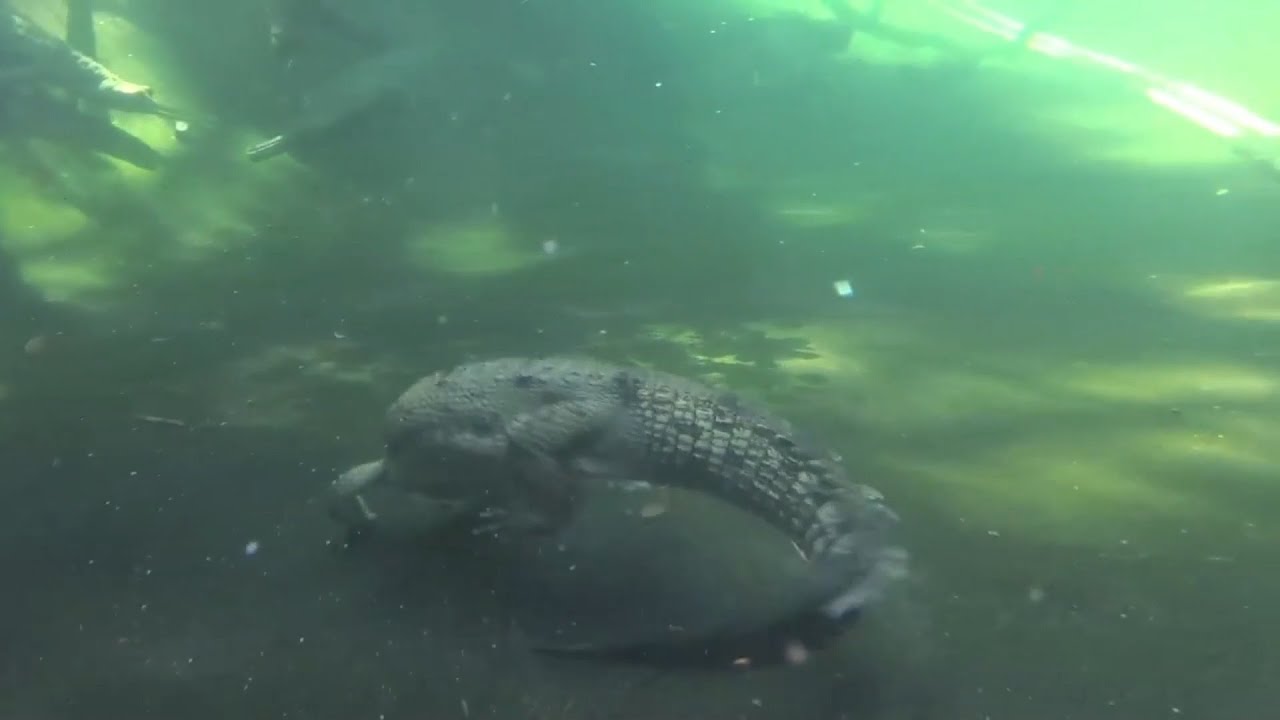– Discover the underwater dining habits of the critically endangered gharial.
– Explore the gharial‘s ancient lineage, tracing back to prehistoric times.
– Learn about the collaborative effort to save gharials from extinction on the Gandak River in India.
—
Embarking on a journey through the swirling eddies of conservation, we’re about to dive beneath the water’s surface for an intimate viewing of a most captivating ritual: the underwater snack time of the critically endangered gharials. These unique creatures, with their elongated snouts and razor-sharp teeth, tap into a lineage that stretches back to the age of the dinosaurs, painting a vibrant portrait of evolution with each snap of their jaws.
The gharial is the sole survivor of its kind, a sentinel of history dating back to the Cretaceous period. Once the rulers of South Asia’s riverine domains, their kind now clings to existence in the fragmented corners of India and Nepal. With less than a thousand mature individuals estimated to remain, the very essence of biodiversity is at stake.
Mirroring a scene from a wildlife documentary, envision the gharial’s underwater escapades—a realm where these reptiles demonstrate remarkable precision. As fish swim by, the gharial snatches its meal with breathtaking efficiency, showcasing an evolutionary design streamlined for piscivory. Yet, as enrapturing as this display is, it is a spectacle shadowed by the specter of endangerment.
Amidst this precarious balance of survival, beacons of hope, such as the Zoo’s partnership with the Wildlife Trust of India (WTI), emerge. Allies in the quest for preservation, these organizations unite with a singular goal: to secure a future for the gharial. Channeling their collective expertise, they’ve launched an initiative that does more than admire these creatures from a distance—it acts to ensure their continuity.
The Gandak River, a lifeline for the gharial, has become a focal point for this conservation endeavor. Recognizing the threat of floods—which can wash away the hopes of a new generation in the form of eggs—the WTI and the Zoo’s team have manifested a life-giving solution. They’ve established a sanctuary for the eggs by building an incubation center. In this place, they can thrive until the hatchlings are strong enough to navigate the currents of their ancestral waters.
In the previous year alone, a trio of dedicated conservationists made the journey to stand alongside WTI, helping them to expand the reach of the Indian Gharial Recovery Program. Their hands-on approach is less about interference and more about gentle guidance, a philosophy underpinned by a respect for nature’s methods. The building of the incubation center is a monument to the idea that human intervention can be both subtle and impactful.
Just as the gharial strikes with pinpoint accuracy, so must the efforts to protect them be precise and well-coordinated. Every step taken is a vital dance with ecological balance. It is about recognizing the high stakes of this conservation game—where the loss of a single species can ripple through the web of life, distorting the complex mosaic of biodiversity that supports us all.
Turning our gaze to the broader canvas, the gharial’s plight is one thread in a tapestry that includes fresh challenges and novel approaches to conservation. One cannot simply consider the protective measures without understanding the creature itself. A relic of ancient times, the gharial shares more than just its habitat with us—it shares a story of adaptation, survival against the odds, and a future that might yet be bright.
As revealing as fossil records and as expressive as an artist’s brush, the gharial’s existence tells a tale that weaves through eons, offering glimpses into a world long gone. Their presence reminds us that the past is not always buried but sometimes swims beside us, cloaked in scales and mystery. Witnessing their feeding is a privilege—a reminder of the sheer wonder that nature holds and of the duty that we, as stewards of the Earth, must embrace.
Central to the conservation discourse is the understanding that our actions reverberate through time and across species. The Zoo’s and WTI’s convergence on the Gandak River is a testament to the power of collective action and shared vision. It is a tale not solely of saving a species but of awakening humanity to the intrinsic value of all life. As if each egg in the incubation center was a world unto itself, the program exemplifies a commitment to nurturing the potential contained within.
Stepping back from the magnificence of the gharial’s feeding, let us ponder our shared journey—a journey of protecting, learning, and coexisting. Through our eyes, the gharial’s struggle and splendor reflect, crafting a narrative that merges the urgency of conservation with the enchantment of the natural world.
Though 2,000 words can only skim the surface of the depths to which our duty to these creatures extends, let each syllable resonate with the importance of the gharial’s tale. As rivers flow and time slips by, may our endeavors ripple outward, ensuring that the song of the gharial—a croon born of ancient epochs—continues to echo along India’s waterways and deep within the heart of conservation’s collective spirit.
*****
Source Description
The gharial is the only surviving member of a group of animals that arose in the Cretaceous period. Once abundant throughout South Asia, Indian gharials exist only in parts of India and Nepal, where fewer than 1,000 mature individuals are estimated to remain. The Zoo has partnered with the Wildlife Trust of India (WTI) to locate, protect, and monitor gharial nest sites along India’s Gandak River. Last year, we sent a three-person team to support WTI in expanding the Indian Gharial Recovery Program’s efforts by building an incubation center that will temporarily relocate eggs away from floods until they hatch. Read more at: https://bit.ly/419VeE8.
#Gharial #Conservation #Reptile


